Update 1: Welcome
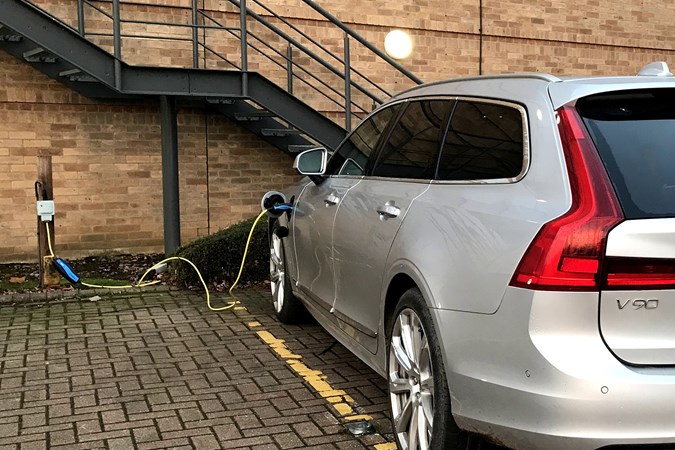
Parkers Editor, Keith Adams (above), ran this Volvo V90 T8 for 8,000 miles in order to ascertain if this Plug-in Hybrid Electric Vehicle (PHEV) is capable of delivering anywhere near the claimed fuel consumption. Or whether it’s simply set up as a high-performance car, with 400hp, and we should consider it that way only – and not as some kind of eco champion.
The V90 T8 impressed in its ability to cover long distances without breaking a sweat, and deliver impressive fuel consumption on the commute. It can’t really do both at the same time, which is something we will get back to when answering the original question of why we’re running this car.
In our full review, we conclude: ‘It’s not perfect with a number of competitors offering greater practicality and a more rewarding driving experience.’
My own view differed from this in one important way – the rewarding driving experience that you get with the V90 is anchored in its refinement, long legs, and calming demeanour. We saw as the miles piled on, but early impressions were that this is a car that appeals to the more mature driver who appreciates taking a measured approach to life.
That it has 400hp to play with merely adds to the effortlessness of the experience.
Try finding the rivals
First thing to say when weighing up the case of our V90 T8 Twin Engine Inscription Pro, is that it’s hardly family-car priced. As the company’s flagship estate car, it came in at a whopping £60,055 (at the time of writing), and with a 0-62mph time of 5.3 seconds, and a maximum speed of 155mph (numbers that don’t flatter it), this is a hybrid car with bags of usable performance.
It’s worth noting that Volvo is keen to do a deal on the V90 range, so don’t conclude that just because there’s a high ticket price, it doesn’t stack up in the monthlies. First place to check is most definitely our Deal Watch page.
What do you get in a £70,000 Volvo?
Hold your horses there. You say £70,000? In the case of our T8 Inscription Pro, absolutely. But only because we’ve plundered the options list to hike the price as tested to £69,405. We’ll describe the options in a later update, and let you know whether they are worth it or not, both in terms of functionality and how they should affect the resale value of your car.
But before we go into detail there, here’s what you get thrown in with all V90s:
- 9.0-inch centre console touch screen with navigation and connected functionality
- 12.3-inch active TFT crystal driver’s information display (below)
- Volvo On Call with app – remote control of various car functions and an emergency and tracking service
- Voice-activated control system
- City Safety – includes pedestrian, cyclist and large animal detection, and front collision warning with AEB
- Pilot Assist and Adaptive Cruise Control
- Oncoming Lane Mitigation – automatically provides steering assistance if you unwittingly drift out of your lane
- Run-off Road Protection
- LED headlights with active high beam
- Dual-zone climate control
- Power-operated tailgate
- Front and rear parking sensors
- Power folding rear-seat backrests and headrests
- Heated front seat
In addition to this kit list, the options fitted to our car include:
- Xenium Pack (£1,800), which includes glass tilt and slide sunroof, 360-degree surround-view camera, Park Assist Pilot (automatic parallel and 90-degree parking)
- 20-inch 10 spoke alloys (£800)
- 4.5m Type 2 charging cable (£50)
- Active Four-C Chassis – adaptive dampers and air suspension (£1,500)
- Blind Spot Information System (BLIS) with steer assist, cross traffic alert and rear collision mitigation (£500)
- Privacy glass (£400)
- Heated Rear Seats (£300)
- Sensus Connect with Bowers and Wilkins sound (£3,000)
- Smartphone Integration with Apple CarPlay and Android Auto (£300)
- Metallic Paint (£700)
So, not only is the V90 fast, cheap to tax, and potentially cheap to fuel if you keep it plugged in and don’t have too long a commute, but it’s stacked with kit that should keep the audiophile gadget fan more than happy.
Update 2: Performance and handling – what’s it like to drive?
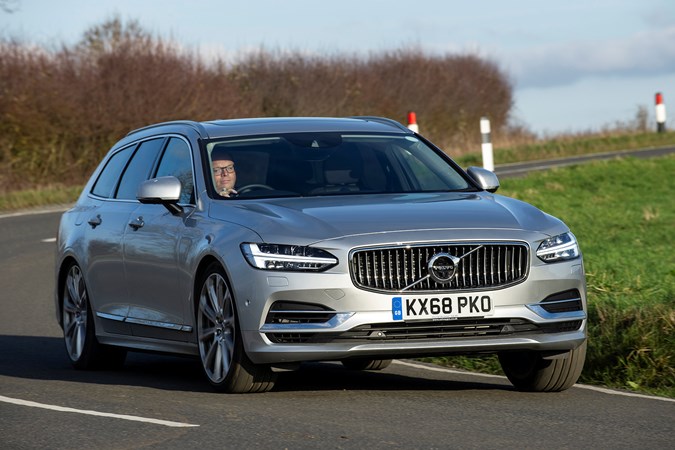
One of the main questions I asked at the beginning of this long-term review is whether this is a performance estate that happens to be a hybrid – or an eco car that’s capable of being very rapid. In reality I’d say that it’s both. And neither. If that makes sense.
First thing’s first – the V90 T8 shares its drivetrain with the XC90 T8, so uses a 316hp 2.0-litre four-cylinder turbocharged engine that’s allied with a 10.4kWh battery pack which is good for 84hp, and can be charged up in two and a half hours. Its claimed electric range is 28 miles, and as such if you’re able to run it on battery-only for your commute, it’ll cost you a couple of quid a day, and you’ll not need to fill it with petrol.
That’s the eco side of the V90 covered, so now let’s get on to the more interesting part of its makeup – the performance. I’ve already commented on how you’ll struggle to find rival estates with similar power. And that list of alternatives drops to zero if you take its plug-in status into account. In short, the V90 is your only option, if you want this power and a plug-in.
How does the V90 go, then?
Rather well, actually. With juice in the battery pack, throttle response and initial acceleration is attention grabbing. Considering the V90 weighs more than two tonnes, a 0-60mph time of around five seconds is crazy-fast. Beyond that speed, it’s more impressive, though – we’ve not fully tested it yet, but the impression we’ve picked up on our runway is that it’s relentless beyond that in a way you’d have needed something like an Audi RS4 to emulate just a couple of years ago.
What’s even more impressive are the overall levels of refinement of the V90 as it dispatches its sports car-baiting performance. With the combined power of the petrol-electric drivetrain, it never sounds or feels strained. Instead, it generates an curious four-cylinder back-beat overlaid by a supercharger-like whine that adds genuine interest. It doesn’t sound melodious like an old-school V6 or V8, but it’s rewarding, nevertheless.
Of course, if you make liberal use of its assertive acceleration, the 25-ish miles of battery life are rapidly depleted. And even if you engage the battery-charge function, it won’t recharge as quickly as it depletes. But wind back your enthusiasm, and it’s unlikely you’ll be left floundering with ‘just’ 316hp for very long.
So, it’s fast… but is it engaging?
It probably won’t surprise you to read that it is not. In dynamic mode, it’s responsive and quick to answer your inputs, but in default hybrid mode, it feels artificial and somewhat isolated. The biggest criticism of this car seems to be reserved for its brakes. I have dialled into them and don’t think about any longer, but other drivers have commented quite unfavourably about them.
Associate editor Gareth Evans describes them as, ‘dead – very old-school hybrid.’ While finance editor Chris Lloyd is far more scathing: ‘that brake pedal is ridiculous. It makes driving the V90 actively tiring.’
The problem comes from them being hooked to a battery-regenerative system, and the transition from regen to pedal-on-disc is too distinct. This makes the pedal feel inconsistent. However, the stopping power is excellent once you get used to this quirk.
Does it handle like a ship in a storm?
You can’t escape the fact it’s a two-tonne car. But despite its porky kerbweight, it handles tidily enough, and is never cause for concern. In slippery conditions, the added security of the battery-assisted four-wheel drive system keeps it all on the straight and narrow.
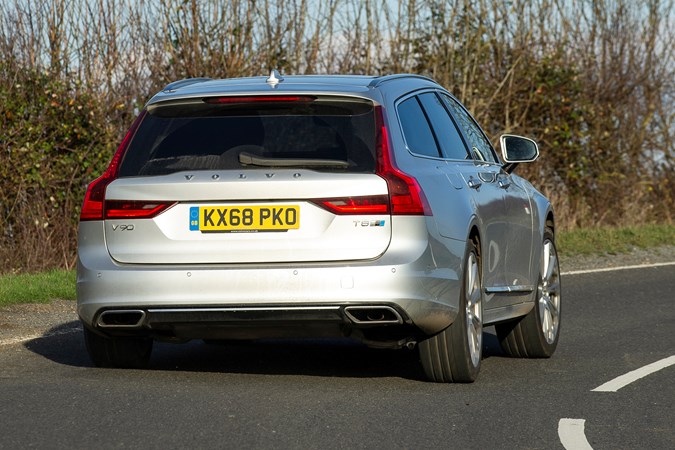
Our car has adaptive damping with rear air suspension, and that allows it to maintain a modicum of serenty on B-roads as long as the corners aren’t too sharp.
As things get more demanding, you’ll not escape the body roll, which isn’t excessive and reasonably controlled. But it’s impossible not to conclude that the V90 is most at home on sweeping A-roads and motorways, where it remains delightfully unflustered.
Pilot Assist
Once you learn to trust it, Volvo’s Pilot Assist adaptive cruise control system works well on motorways and fast-flowing A-roads. Don’t consider it a hands-off system – no adaptive cruise control should be treated this way. Instead, use it as a way of assisting you on longer drives, gently helping you steer and maintaining distances from the traffic around you. In a nutshell, I found using it hugely beneficial on long drives, and it really is a great way of staving of tiredness.
And the best bit of all is that it’s standard on all S90 and V90 models.
Read a more detailed account in the interior section of this full review
So, is it a performance estate or a quick eco car?
No question – it’s a performance estate. But one that’s not going to set the world alight dynamically. Instead, it wields its big stick to make light of long-distance journeys, and allow the driver to come aways from a big stint at the wheel unflustered and ready for more. If you want a pure driver’s car, look elsewhere, but then it’s unlikely that anyone looking for a driver’s car would come knocking on the door of the V90 anyway.
I’m enjoying the duality of the experience. I’m increasingly kicking back on my commute and pushing it along gently on battery only (I’ll report back on that anon), but revelling in its power and poise on fast weekend runs north.
And right now, the V90 T8 is peerless in that respect. I can plug in at home and work (which makes me luck enough for this approach to suit my lifestyle) and effectively run it on pennies during the drag of the commute. But at the weekend, it transforms into a powerful and assured petrol-powered long-distance cruiser.
That doesn’t half make for interesting diversity in my fuel returns.
Update 3: Interior and behind the wheel

Given that this car’s main USP is as a supremely-competent mile muncher, and one that’s been designed to keep its driver as relaxed as possible for the longest amount of time, I thought it would be a great opportunity to discuss this in detail. The seasonal break-up is always a good opportunity to put a car to the test, with multiple relatives and friends to visit – and in the case of my complex life, that often involves driving from one end of the country to the other on a regular basis.
The good news is that the Volvo V90 passes the long-distance test with ease. The first impressions are that the dash layout is clear and logical, and although it took me a little while to familiarise myself with the Sensus infotainment system’s screen, everything is simple and stress-free to use. I’m still not a fan, but as Apple CarPlay works seamlessly, I’m wedded to that system instead of Volvo’s own idiosyncratic set-up.
The driver’s seat is well shaped and electrically adjustable in a myriad of ways, but if I were being hyper-picky, it could do with another inch or so of rearward travel. Being a refined and well-insulated petrol hybrid means that mechanical intrusion is kept to a minimum, from silent getaways to hushed cruising, the Volvo’s been tuned to keep the driver refreshed and happy.
This thoughtful attention to detail extends to the Volvo’s climate control system, which keeps the driver fresh – on account of it’s simple set-up and CleanZone set-up.
Update 4: Comfort
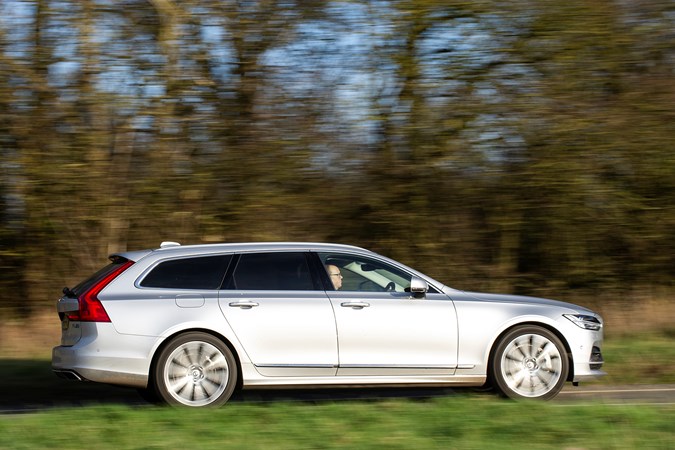
How does the V90 stack up for interior comfort? Very well indeed. Okay, so the fundamentals are there: the driver’s seat is firm and supportive, the controls are well set-up, and the air quality is always top notch. But once underway, these merely form firm foundations for excellent long-distance well-being.
Over Christmas, it covered a couple of 500-mile days (Cumbria to the Midlands and back), and I didn’t raise a sweat. If only it would do more than 390 miles on a tank, though.
As per usual, it’s worth me mentioning that the T8’s ‘stout’ mid-range acceleration makes light work of overtaking, while its long gearing means that it settles down to a near-silent cruise. A big factor in its comfort are the heated, massaging seats, which offer a number of programmes to reinvigorate tired back muscles – that really does work.
Finally, I’ll also make mention of Pilot Assist, which plays a big part in the car’s long-distance ability. On the motorway, it adds a useful dose of ‘sneeze factor’, and allows the car to take the strain in busy traffic. Especially in traffic jams when it all-but takes over from you.
In all of this, I’d say that you probably have little advantage over a diesel-powered V90 – that has equally long legs, is refined at speed, and it goes a whole lot further on a tank of fuel.
So it’s a good job, I’ve spent some time in a V90 D4 diesel by way of comparison for you – I’ll feed back my thoughts and findings on the whole diesel vs petrol question in the next update.
Update 5: Fuel consumption
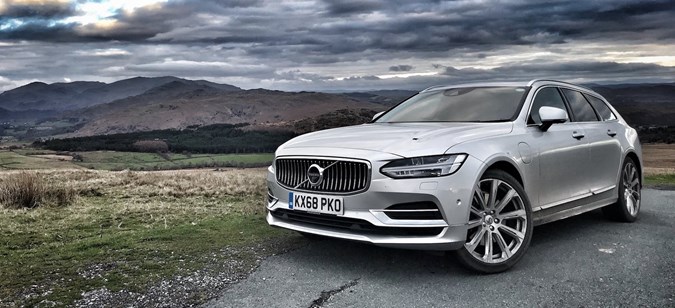
The Volvo V90 T8’s ability as a long-distance cruiser is pretty much incomparable. The massaging and heated seats are magnificent, the ride is firm but well damped, and the overall levels of refinement are excellent. In addition to this, the Bowers and Wilkins in-car entertainment set-up is fantastic for those who love their music immersive, and beautifully reproduced.
However, I like to crack on once I’m on a long journey, and one thing that annoys me is a car with a short range. Of course, this is all relative because after six months in a Volkswagen e-Golf, with its c.120-mile range, the 350-or so I can realistically squeeze out of the V90 isn’t too bad at all. But in reality, I’m constantly annoyed by cars that won’t crack 400 miles on a tank – and in this age of shrinking fuel tanks, it’s becoming a more regular occurence.
My V90 averaged 33mpg, and this isn’t too bad at all considering its performance. But on a long run, with the battery flattened, and running in self-charging hybrid mode, it’ll struggle to beat 30mpg. And as we’re limited to a 50-litre (that’s 11 gallons for pre-millennials), it’s not going far enough non-stop for my liking. Diesel would definitely fix that.
Considering its performance, and the way that you can commute as a PHEV, I think that’s a very good fuel consumption figure really. But how does it stack up against the more conventional diesel?
Diesel V90 versus PHEV
Taking delivery of the curious Ocean Race edition, and jumping in for the first time is an interesting experience. Volvo interiors are classy places to spend time these days, but they can be a little monochrome. That’s not the case here – orange seatbelts add an unusual splash of colour to a very familiar place. We’re lacking some of the T8’s luxury equipment, but overall, it’s far from poverty spec.
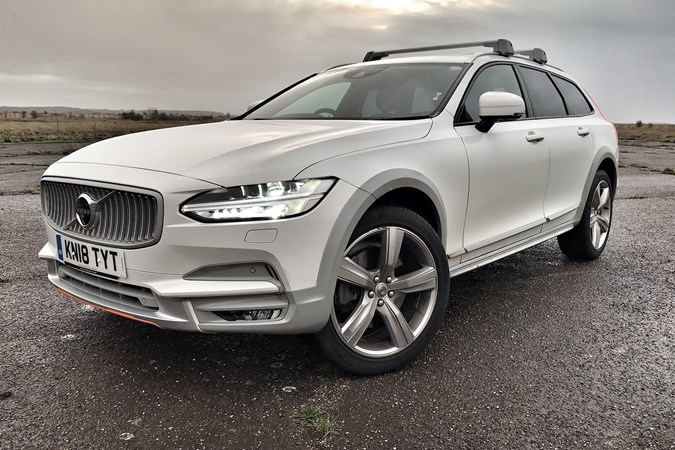
Firing it up is a rude awakening after months in the hybrid. The diesel idle clatter is inescapable, and although it settles down reasonably well once you’re underway, it’s still lacking in refinement compared with its hybrid sibling or its best rivals. Being the Ocean Race based on the Cross Country, it’s a given that the ride is better, and it rolls more in bends thanks to raised suspension. Once on the motorway, it hunkers down nicely, though, and other than the wind rustle from the roofbars, it’s pretty much as quiet as the hybrid.
As a long-distance cruiser, there’s little in it. Yes, I miss the overtaking punch of the T8, but the diesel’s far from lacking in outright pace. In addition, it is blessed with oodles of mid-range punch to play with. The big difference is expected – on a 1,000-mile motorway-packed weekend, the D4’s 40+mpg potential gives it nearer 500 miles to play with on a tank. And when you’re driving overnight, that’s a very positive aspect.
So, would I ditch the hybrid V90 for a diesel?
I won’t beat around the bush here: definitely not. However, that’s my very subjective opinion on the matter. I’m lucky enough to have my fuel expensed, which probably stands true for most V90 users.
So, the fuelling costs for long-distance driving (it cost 20% less to fuel over 1,000 miles) aren’t as much of an issue as they might be. In addition, the benefits of a PHEV on a local commute are undeniable.
But for those who are closer to their fuel expenses, and who cover more than, say, 20,000 miles a year, then the diesel makes a huge amount of sense. I could easily see why so many people on the Parkers team were more than happy to take the D4 over my T8.
As an aside, I enjoyed childish glee at the way this white Volvo with roofbars was capable of clearing the outside lane of the motorway. Can’t think why…
Update 6: Verdict

Our six-month test of the Volvo V90 T8 Inscription all-too soon, and it’s now time for a verdict. Does this pleasant, well-designed Swedish estate work for us in PHEV form, or would you be better off saving money and plumping for a diesel version?
Fuel economy
Here’s where it gets interesting, and the reason why we ran a T8. Over the 8,000 miles I drove the V90, it averaged 33.5mpg. Given that there were lots of fast miles covered on the motorway, I’m not unhappy with the result. A big diesel would knock that into a cocked hat, of course, but then, a big diesel would go nowhere near touching the T8’s performance.
However, if you’re commuting to the railway station from your nearby home, and you have it plugged-in to your wallbox at home, the picture changes significantly. On a week of solely commuting (32-mile round trip) and charging every night at home, it delivered 112mpg, and cost £2.00 per charge up of electricity. It never ran exclusively on battery on my commute (slightly too long a round trip), but did most of it, especially if I was reasonably gentle with the throttle.
If you can charge up at the office (below), even more of an incentive
Engine
With 320hp without hybrid assistance and 400 with it, you’d be forgiven for wondering whether all the extra weight and fuss of the batteries and motors that come with the hybrid system are worth it. It’s not as if it’s not powerful enough anyway – but I personally liked its power delivery, and when charged up, that additional smoothness makes it even more satisfying.
Yes, I like a fast car, but it’s not just about that. The four-cylinder engine isn’t the smoothest one out there by a long chalk, so the PHEV side to its character takes a lot of that away, and really helps in delivering silent slow-speed running and getaways.
Handling
Those massive 20-inch alloys are fitted with super-wide tyres, which mean you get plenty of grip at all times, and as a consequence its handling is predictable, safe and planted. Would I describe it as good, though? Not really, as it’s too heavy to ever feel happy in the bends. Capable, but far from happy is the best way of summing it up.
Oh, and those brakes really are dreadful…
Ride and comfort
The V90’s air suspension does a great job of masking the thump-thump from those wheels when it hits anything other than smooth roads. It’s not as settled as smaller-wheeled V90s, which really are excellent. Despite that, it’s still a supremely comfortable long-distance cruiser, and seems to get more so the faster you go. No doubt, the amazing seats are a big contributing factor in this, too.
Interior and Equipment
The T8 Inscription is very well equipped, with all the comfort, convenience and safety features you’d ever want. With a fully-featured infotainment set-up, online services, and Pilot Assist as standard, it has everything covered. Of course, so it should at the price.
The fit and finish are also very good, with special mention being made for the choice of trim materials, which are pretty much the best you’ll find for the money. There are some curious oddities, though, not least the rotary starter control, which just feels cheap and gimmicky, and the instruments, which lack the crispness and visual appeal of more modern rival all-digital set-ups.
And a final word for that B&W stereo, which sounds magnificent. If you’re paying for your V90 with someone else’s money (it’s a very expensive extra), you should definitely tick that option.
Should you buy a Volvo V90?
As you’ll read in the rest of the full review, we like and have a great deal of time for the Volvo V90. It’s comfortable, great looking, and a brilliant long-distance cruiser. There are also some decent deals available on it if you shop around. But that’s the case of any V90.
So, would I recommend going the PHEV route over a more solid D5 diesel? Probably not on rational grounds. It’s too expensive taking performance out of the equation, and unless you meet a certain set of circumstances, you simply won’t feel the financial benefit of plugging in.
Irrationally, though – I love it, and could easily make a case for it. As long as someone else is paying the bills.
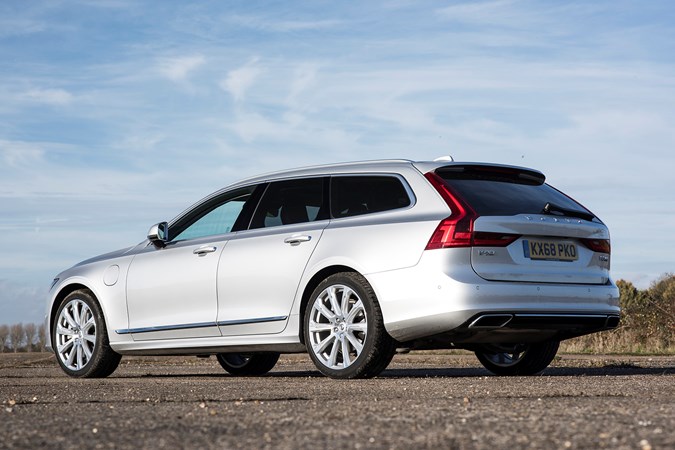
Just so you know, we may receive a commission or other compensation from the links on this website - read why you should trust us.

